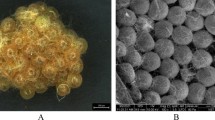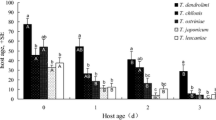Abstract
Non-choice laboratory experiments were conducted to evaluate the influence of host acceptance, previous rearing host, host age and the contact time between parasitoids and host on the efficacy of Trichogramma cacoeciae Marchal and T. principum Sug. et Sor. against the codling moth Cydia pomonella. The tendency of T. cacoeciae and T. principum females to attack the codling moth was similar to E. kuehniella, and it was not affected by the previous rearing host. T. cacoeciae showed a greater preference for codling moth eggs than T. principum. A high mean number of emerged F1 progeny was observed when both parasitoids were sequentially reared on codling moths. Codling moth acceptance, the number of parasitized eggs and the number of emerged progeny were higher when younger codling moth eggs were offered. The tendency of female parasitoids to oviposit remained unchanged when the contact time with the host was prolonged. When the contact time was increased, the number of parasitized eggs and emerged offspring was higher. The results showed that the codling moth fertility (egg hatch) was reduced when younger eggs were offered and when the contact time with the parasitoids was increased. T. cacoeciae was more efficient in reducing codling moth fertility. The current study provided essential information necessary to increase the efficiency of T. cacoeciae and T. principum against the codling moth.


Similar content being viewed by others
References
Almatni WS (2003) Survey and study of natural enemies of codling moth, Cydia pomonella L. in As-Sweida, and evaluation of some bio-agent measures (in Arabic). PhD Thesis, University of Damascus, Syria
Barnay O, Pizzol J, Gertz C, Kienlen JC, Hommay G, Lapchin L (1999) Host density-dependence of discovery and exploitation rates of egg patches of Lobesia botrana (Lepidoptera: Tortricidae) and Ephestia kuehniella (Lepidoptera: Pyralidae) by the parasitoid Trichogramma cacoeciae (Hymenoptera: Trichogrammatidae). J Econ Entomol 92(6):1311–1320
Bjorksten TA, Hoffmann AA (1995) Effects of pre-adult and adult experience on host acceptance in choice and non-choice tests in two strains of Trichogramma. Entomol Exp Appl 76:49–58
Bloem S, Bloem K, Knight AL (1998) Oviposition by sterile codling moths, Cydia pomonella (Lepidoptera: Tortricidae) and control of wild populations with releases of sterile moths and egg parasitoids. J Entomol Soc Brit Columbia 95:99–109
Bruines EBA, Wajnberg E, Pak GA (1994) Genetic variability in the reactive distance in Trichogramma brassicae after automatic tracking of the walking path. Entomol Exp Appl 72:297–303
Calvin DD, Losey JE, Knapp MC, Poston FL (1997) Oviposition and development of Trichogramma pretiosum (Hymenoptera: Trichogrammatidae) in three age classes of southwestern corn borer eggs. Environ Entomol 26(2):385–390
Dolphin RE, Cleveland ML ( 1966) Trichogramma minutum as a parasite of codling moth and red banded leafroller. J Econ Entomol 59:1525–1526
Ehler LE, van den Bosch R (1974) An analysis of the natural biological control of Trichoplusia ni (Lepidoptera: Noctuidae) on cotton in California. Can Entomol 106:1067–1073
Gomez LR, Diaz AE, Lastra LA (1995) Selection of strains of Trichogramma exiguum for controlling sugar-cane borers. Les Colloq INRA 73:75–78
Iren Z, Gurkan S (1971) Area of appearance sand effects of the egg parasite, Trichogramma evanescens Westw. on the codling moth, Laspeyresia pomonella L. in Central Anatolia. Bitki Koruma Bulteni 11:157–168
Klomp H, Teerink BJ (1967) The significance of oviposition rates in the egg parasitoid Trichogramma embryophagum Htg. Arch Neerl Zool 17:350–375
Klomp H, Teerink BJ, Ma WC (1980) Discrimination between parasitized and unparasitized hosts in egg parasitoid Trichogramma embryophagum (Hymenoptera: Trichogrammatidae): a matter of learning and forgetting. Neth J Zool 30:254–277
Lewis WJ, Nordlund DA (1985) Behaviour-modifying chemicals to enhance natural enemy effectiveness. In: Hoy MA, Herzoh DC(eds) Biological control in agricultural IPM systems. Academic Press, Orlando, pp 80–101
Marec F (1990)Genetic control of pest Lepidoptera: Induction of sex-linked recessive mutations in Ephestia kuehniella (Pyralidae). Act Entomol Bohemoslov 87:445–458
Miura K, Matsuda S, Kobayashi M (1994) Discrimination between parasitized and unparasitized hosts in an egg parasitoid Trichogramma chilonis ishii (Hymenoptera: Trichogrammatidae). Appl Entomol Zool 29:317–322
Monje JC, Zebitz CPW, Ohnesorge B (1999) Host and host age preference of Trichogramma galloi and T. pretiosum (Hymenoptera: Trichogrammatidae) reared on different hosts. J Econ Entomol 92(1): 97–03
Nordlund DA, Lewis WJ, Altieri MA, (1988) Influences of plant-produced allelochemicals on the host /prey selection behavior of entomophagous insects. In: Barbosa P, Letourneau D (eds) Novel aspects of plant–insect interaction. Wiley, New York, pp 65–90
Pak GA (1988) Selection of Trichogramma for biological control. PhD Thesis, Agricultural University of Wageningen, The Netherlands
Pak GA, Buis HCEM, Heck ICC, Hermans MLG (1986) Behavioural variations among strains of Trichogramma spp.: host-age selection. Entomol Exp Appl 40:247–258
Park GA, Berkhout H, Klapwijk J (1991) Do Trichogramma seek for hosts? Colloq INRA 56:77–80
Parra JRP, Zucchi RA, Silveira Neto S (1987) Biological control of pests through egg parasitoids of the genera Trichogramma and Thrichogrammatoidea. Mem Inst Oswaldo Cruz, Rio Janeiro 82:153–160
Pratissoli D, Parra JRP (2000) Fertility life of Trichogramma pretiosum (Hym., Trichogrammatidae) in eggs of Tuta absoluta and Phthorimaea operculella (Lep., Gelechiidae) at different temperatures. J Appl Entomol 124:339–342
Reznik SYa, Umarova TYa (1990) The influence of host’s age on the selectivity of parasitism and fecundity of Trichogramma. Entomophaga 35(1):31–37
Reznik SYa, Umarova TYa, Voinovich ND (1997) The influence of previous age on current host acceptance in Trichogramma. Entomol Exp Appl 82:153–157
Reznik SYa, Voinovich ND, Umarova TYa (2001) Long-term egg retention and parasitization in Trichogramma principum (Hym., Trichogrammatidae). J Appl Entomol 125:169–175
Stevens P (2000) Developmental biology of two species of leafroller egg parasitoids. NZ Plant Prot 53:168–172
Varela LG, Welter SC, Jones VP, Brunner JF, Reidl H (1993) Monitoring and characterization of insecticide resistance in codling moth (Lepidoptera: Tortricidae) in four western states. J Econ Entomol 86:1–10
Yu DSK, Hagley EAC, Laing JE (1984) Biology of Trichogramma minutum Riley collected from apples in southern Ontario. Environ Entomol 13(5):1324–1329
Acknowledgements
We thank I. Othman (Director General of the Atomic Energy Commission of Syria), N.D. Sharabi (Head of Department of Agriculture) for their help and support and A.Z. Ahmadi for valuable remarks and suggestions.
Author information
Authors and Affiliations
Corresponding author
Rights and permissions
About this article
Cite this article
Makee, H. Factors influencing the parasitism of codling moth eggs by Trichogramma cacoeciae March. and T. principium Sug. et Sor. (Hymen. Trichogrammatidae). J Pest Sci 78, 31–39 (2005). https://doi.org/10.1007/s10340-004-0064-3
Received:
Published:
Issue Date:
DOI: https://doi.org/10.1007/s10340-004-0064-3




